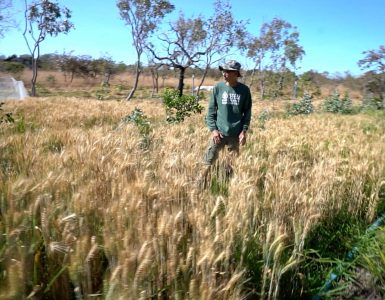


Authors: José Fernando dos Santos Rebello (1), Daniela Ghiringhelo Sakamoto (2)
Linguistic review: Dayana Andrade and Maria Teresa Mhereb
Translation: Maria Teresa Mhereb and Ana Luísa Mhereb
(1) Biologist and Agronomist. Environmental Analyst of Chapada dos Veadeiros National Park – ICMBio and founder of CEPEAS (2) Agronomist and Pedagogue. Founder of CEPEAS.
Since May 2018, under the guidance of Ernst Götsch, the Center for Research in Syntropic Farming (CEPEAS) has been conducting several experiments in order to find the best spacing and the best combination of cultivated plants, especially grains, with tree lines and several varieties of grass and other hedging plants. These experiments seek to simulate how large scale syntropic farming will be used for grain cultivation. We still do not have the machines designed by the researcher Ernst Götsch; therefore, all operations were performed using a microtractor or manually. All experiments were performed using no agrochemicals (zero pesticides, zero herbicides and zero chemical fertilizers). The soil in which the experiments were carried out is part of the Bambuí formation, characterized by a 2-billion-year-old soil with few bioavailable nutrients, having mainly quartzites as its source rock.
EXPERIMENT I
Experiment with wheat (Triticum sativum L.) and Mombaça grass (Panicum maximum)
Wheat originates in ancient Mesopotamia, more specifically in the region of Syria, Jordan, Turkey and Iraq, according to archeology articles. Humans have been cultivating wheat for at least 6,000 years, back when they still used rustic stones in order to grind the grain and remove the flour. Traditionally, wheat is grown at a spacing ranging from 17cm to 20 cm, with 70 to 100 seeds per linear meter. The experiment sought to cultivate wheat along with grass lines, having tree lines every 6 m. This prevents plowing the soil, therefore reducing erosion, compaction, loss of water, loss of organic matter, death of the soil microlife, and also not using herbicides, since grass plays the role of keeping the soil covered, avoiding the growth of other herbs. The implements that are being developed by Ernst Götsch are light and mobilize very little soil, exposing a minimal fraction of it, thus avoiding awakening the invasive herbs seeds from the seed bank. This way, we privilege our wheat seed, which finds a soft and uncompressed soil, with mulch, moisture and a diverse and active microflora and microfauna, thanks to the abundant carbon and rhizosphere that create the ideal conditions for its germination and development.
The experimental area was chalked (800 kg/ha) and tilled with a microtractor. In our first planting, we doubled the spacing between the wheat lines to 40 cm and doubled the number of seeds, placing 140 seeds per linear meter. In the space between lines, we sowed mombaça grass (Panicum maximum). Fertilization was performed with rock dust, thermophosphate and chicken manure.
In our region (Northeast of Goiás – Central Plateau of Brazil), wheat is planted over the months of March and April, after the soybean or maize harvest. Hence it is possible to grow it without irrigation, depending on the terrain. As the experiment was implemented at the end of May 2018, it was necessary to irrigate, since the dry season usually begins in April / May decreasing rainfall, which ceases completely in June, occurring to rain only in October or November, with some rainfall at the end of August known as “Cashew Rain”. Due to the short photoperiod and the mild temperatures, it was not necessary to mow the grass at any time. Grass has grown slowly during the wheat cycle and it indicates great possibilities for temperate countries that traditionally cultivate wheat.
The harvest occurred in September, as the soil was covered all the time by wheat plants and grass in the space between lines. The yield was around 2 tons per hectare. However, it is important to emphasize that the yield would have been higher if irrigation had stopped during flowering, as this increases flower fertilization. One of the reasons for having a production below the national average (which is 2.8 tons per hectare when planted to monoculture) may have been the poor fertilization, which we seek to correct in subsequent crops.
Grain cultivation lines range from 4 m to 6 m and native trees, fruit trees, native and exotic wood are planted around them. With the pruning and annual grinding of native trees, wood and banana (keeping the trees always 5 m high), it is possible to continue growing grains indefinitely in the tree corridors, creating a positive reinforcement cycle for soil fertility and for the growth of grains, grass, fruit and wood, generating, after fifteen years, the eucalyptus harvest and, after 25 to 30 years, the harvest of noble trees (hardwood), being possible throughout this time to cultivate grain and forests, indicating the enormous potential of syntropic farming to produce grain and reclaim our forests. In a long-term period, according to the calculations of the researcher Ernst Götsch, planting forests can be 8 times more profitable than grains, without even taking into account all the ecosystem benefits generated for the planet and its inhabitants, such as: the absence of toxic substances sprayed on crops, air, soil and water; increased soil fertility; production of foods with high biological value (very high vitality); recovery of springs and water production. If we turn this into a monetary value, it can be dozens of times more profitable than conventional agriculture, for we walk in the flow of life to make life thrive.
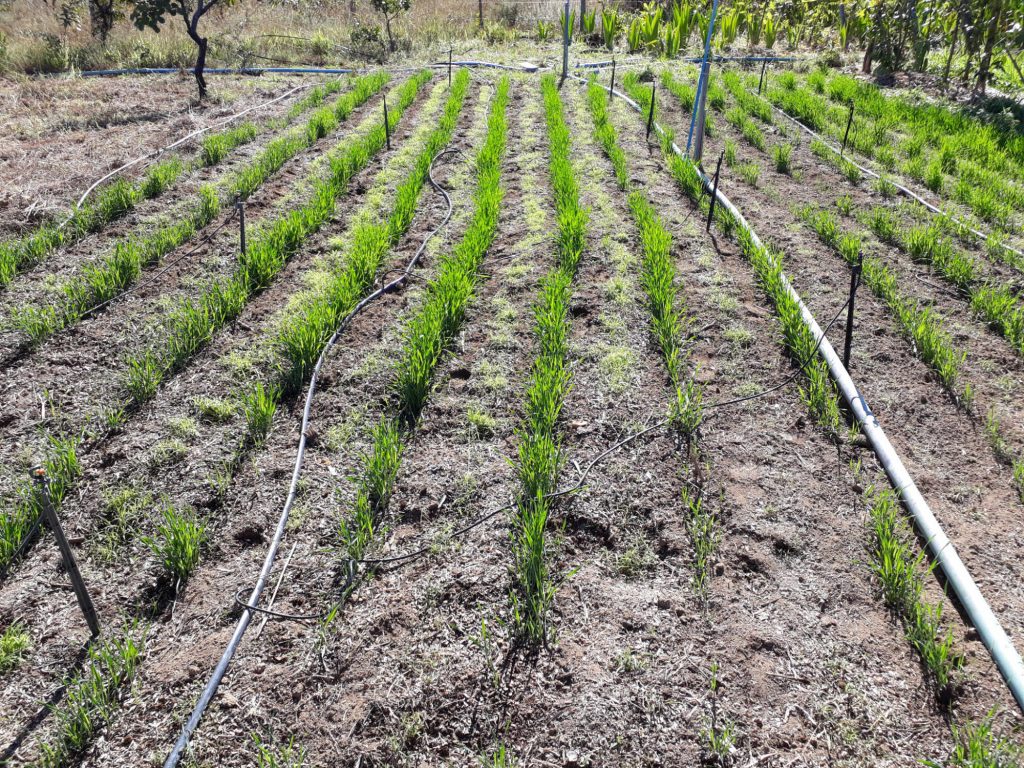
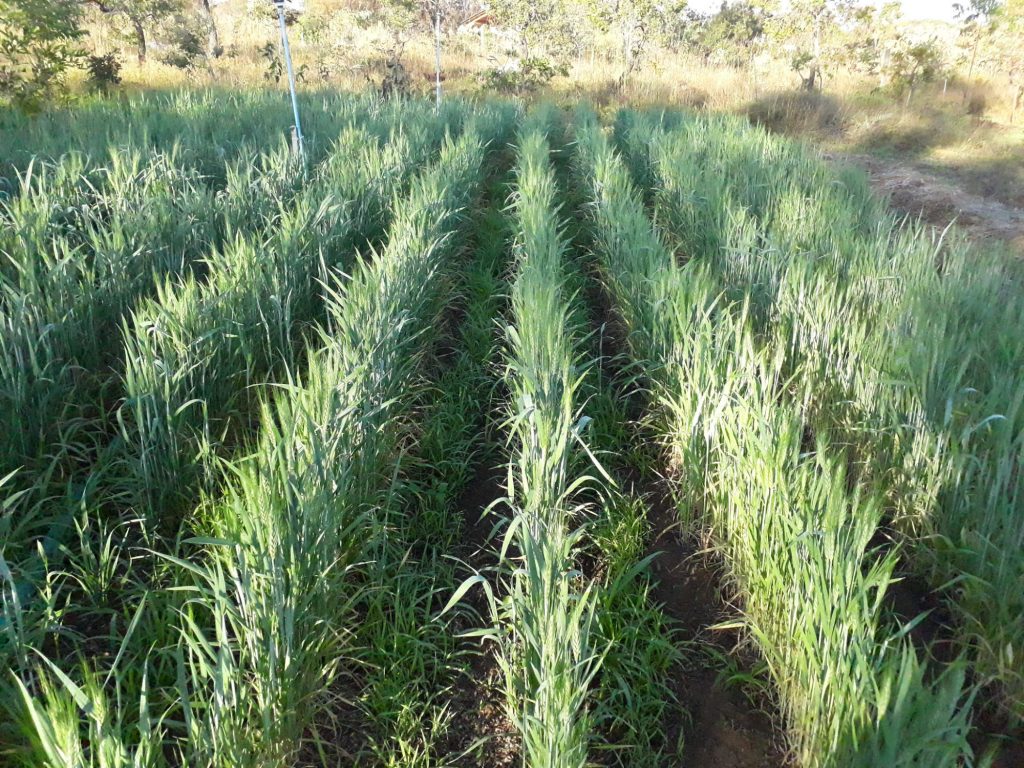

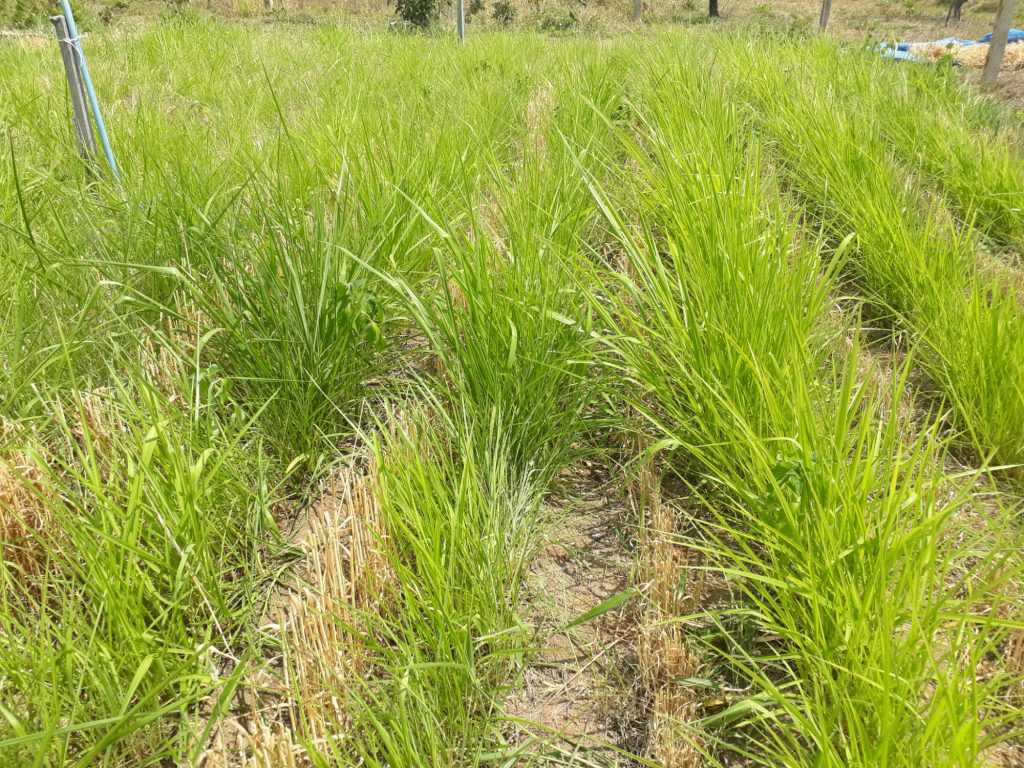
EXPERIMENT II
Maize (Zea mays L.) planted in an area already established with Mombaça grass (Panicum maximum).
Maize is a well-known cereal cultivated in many parts of the world, extensively used as human or animal food, due to its nutritional qualities. All scientific evidence suggests that it is a plant of Mexican origin, since its domestication began between 7,500 and 12,000 years ago in the central area of Mexico. Maize is the kind of plant that is most sensitive to variation in plant density. For each production system there is a population that maximizes grain yield. The ideal population to maximize maize yield varies from 30,000 to 90,000 plants per hectare, depending on water availability, soil fertility, crop cycle, sowing season, and line spacing. In this experiment, a variety of creole maize from Rio Grande do Sul was sown.
The testing area is located near the border of the National Park Chapada dos Veadeiros. The planting occurred in an area where wheat had been previously planted with mombaça 5 months earlier. Thus, maize was alternately sown with the wheat lines. As the wheat spacing was 40 cm long, maize was sown every 80 cm, one seed every 20 cm.
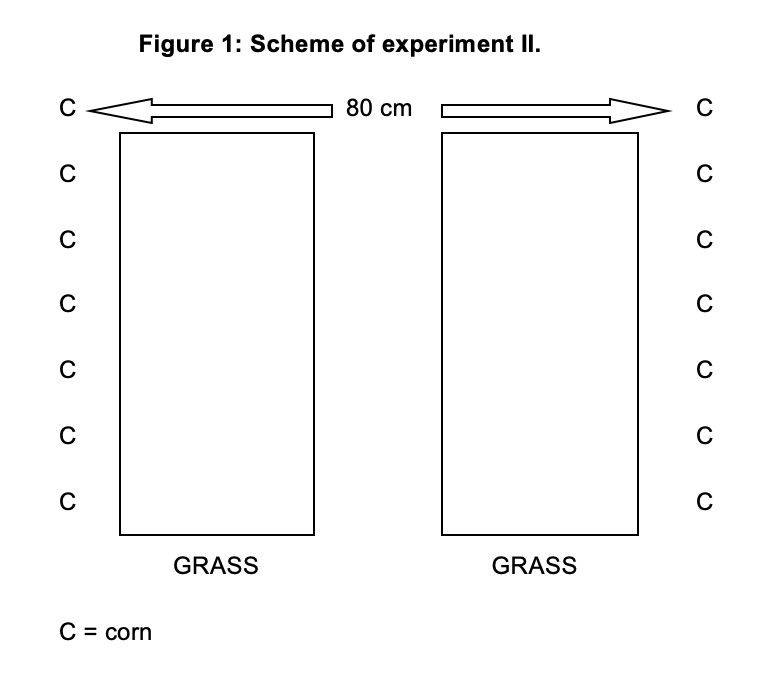

In this experiment, maize developed very well. However, as the experiment area was short and there was an intense cob predation by the native birds, it was not possible to calculate the yield.
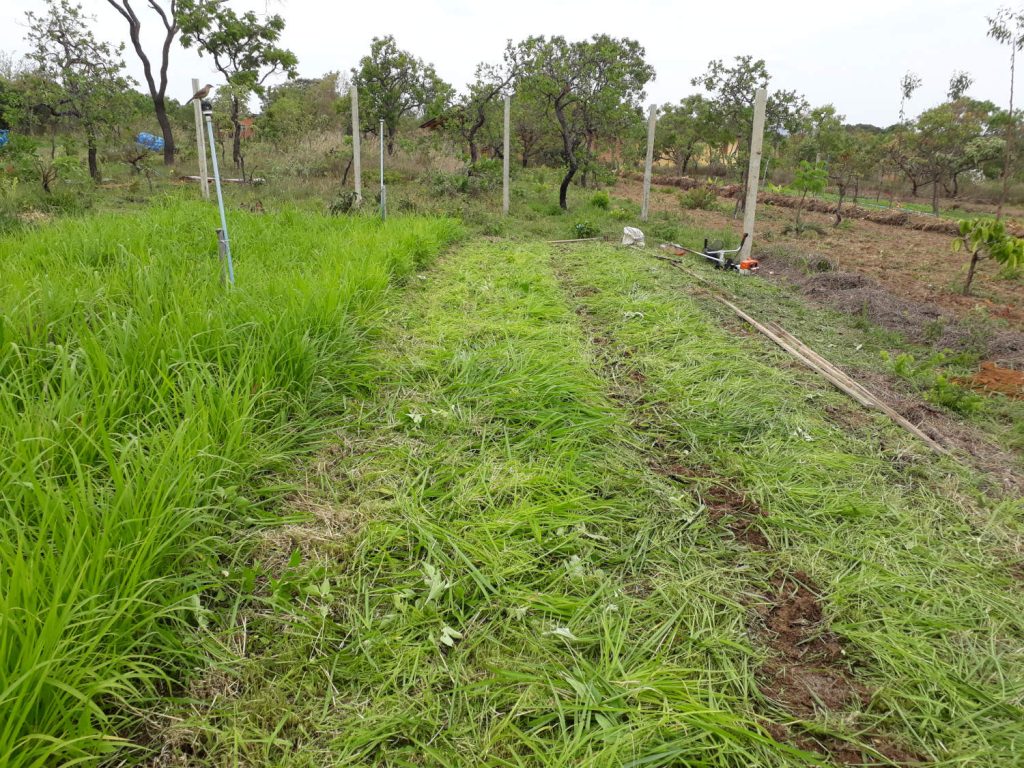
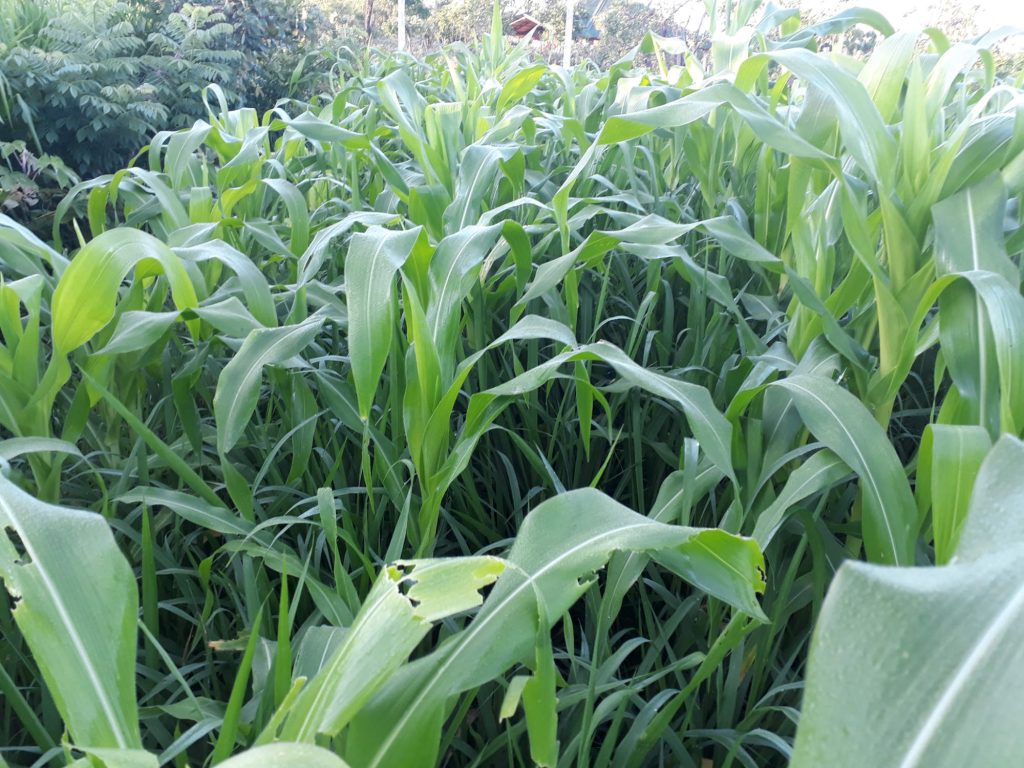

EXPERIMENT III
Maize sown with mombaça grass and tree lines.
A variety of creole maize grown in Chapada dos Veadeiros was sown for more than 100 years. This variety presents ears of maize of excellent covering, perhaps due to the selection made by the own farmers because of the great amount of wild birds that, in this region, rip the ears of maize to eat the grains. Maize was sown at the same time as the mombaça grass (Panicum maximum). In this case, grass was mowed only twice, as shown in Table 2 (below).

Next year, maize will be planted again in this area along with the established grass, which will be mowed at the time of maize planting and once again 8 days later, as it sprouts vigorously. Hence, there will probably be grass mowing two more times, preventing grass from overtaking and lowering maize, as it is an emerging species.
If the farmer chooses to make maize silage, grass can only be mowed twice, so it is possible do harvest the maize along with the already grown grass. In this experiment, the yields obtained regarding maize were of 6800 kg/ha.
Ground Preparation
A line of 1,5-year-old eucalyptus was used. All branches located at the bottom of the eucalyptus (approximately 3m high) were cut and those higher than 4m had their tips pruned, remaining some branches near the cut to stimulate and accelerate the sprouting. Among the eucalyptus, native trees were sown, such as Jequitibá (Cariniana legalis), Ingá de conta (Inga sp), Peroba poca (Aspidosperma cylindrocarpon) and banana prata (Musa acuminata).
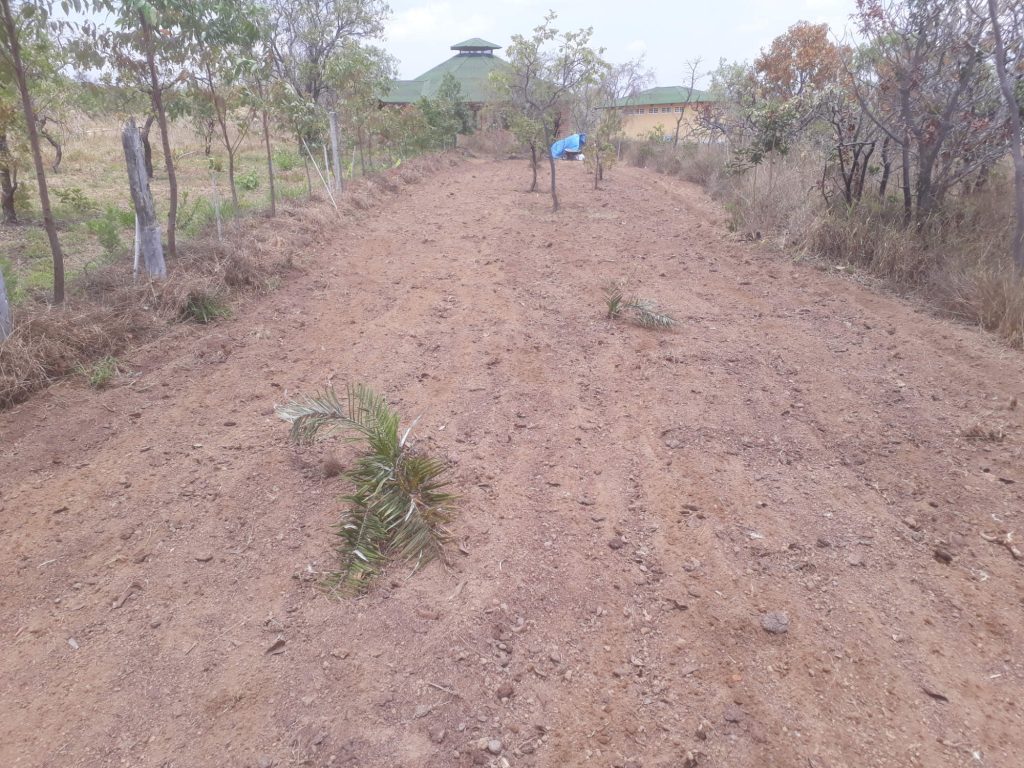
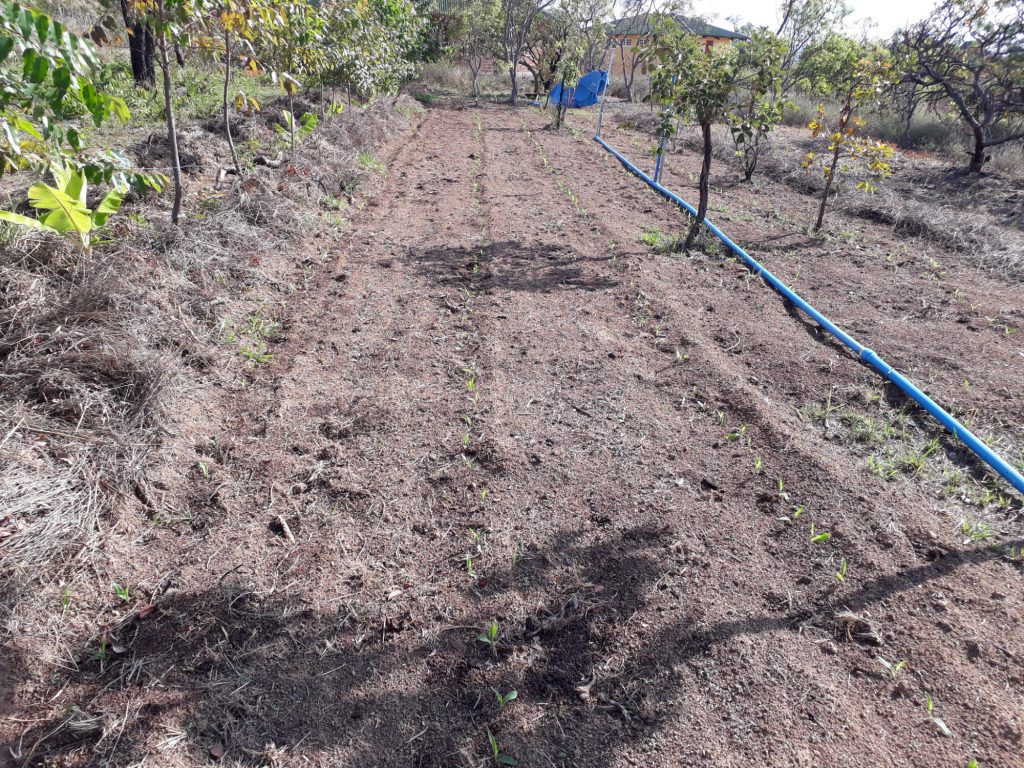

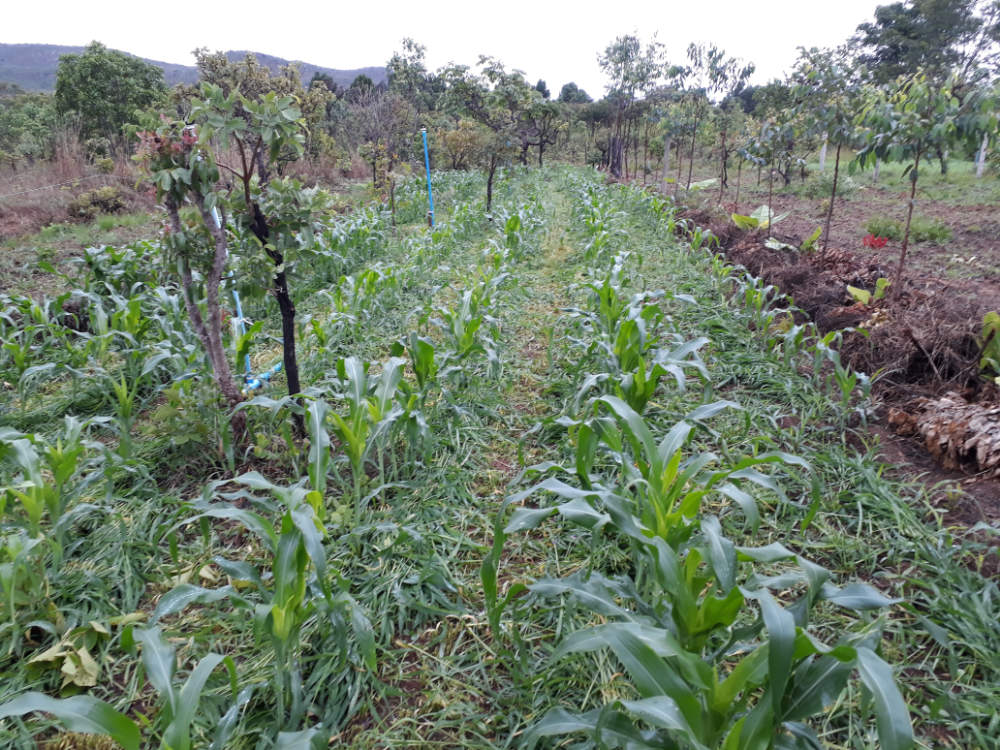
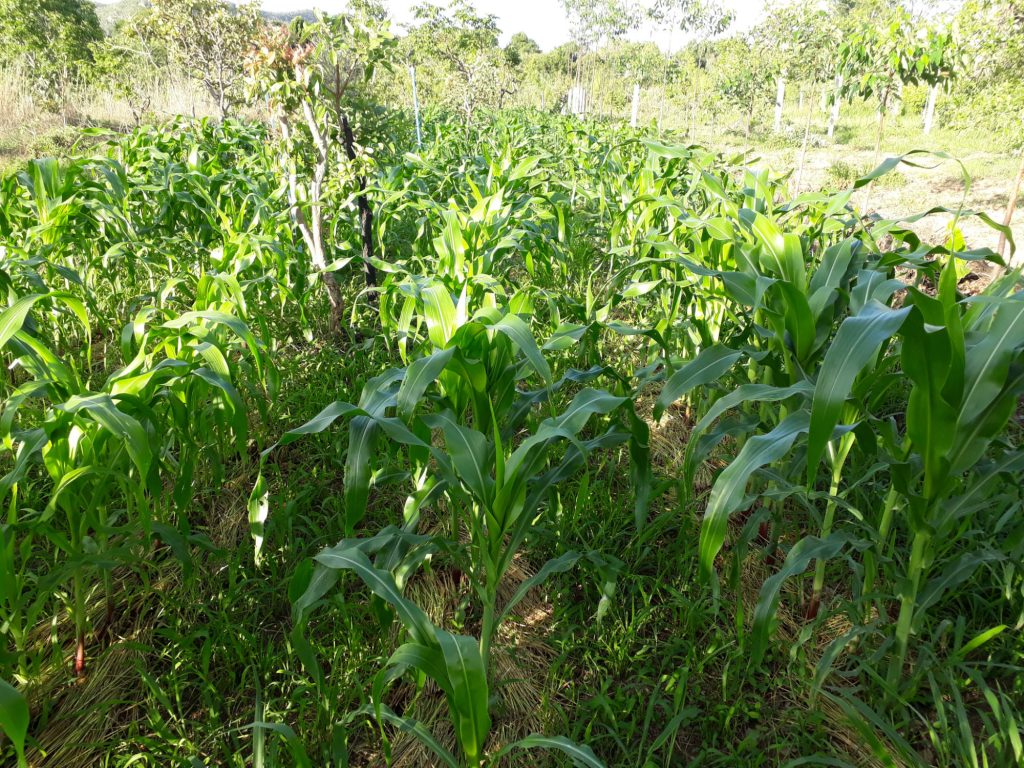
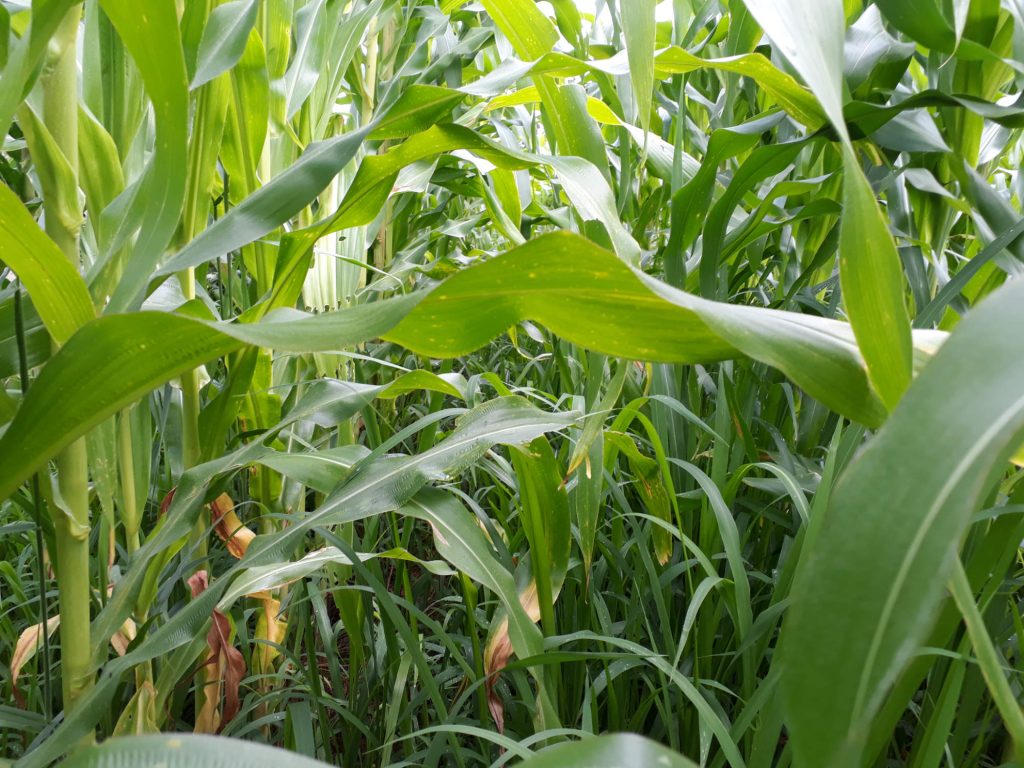
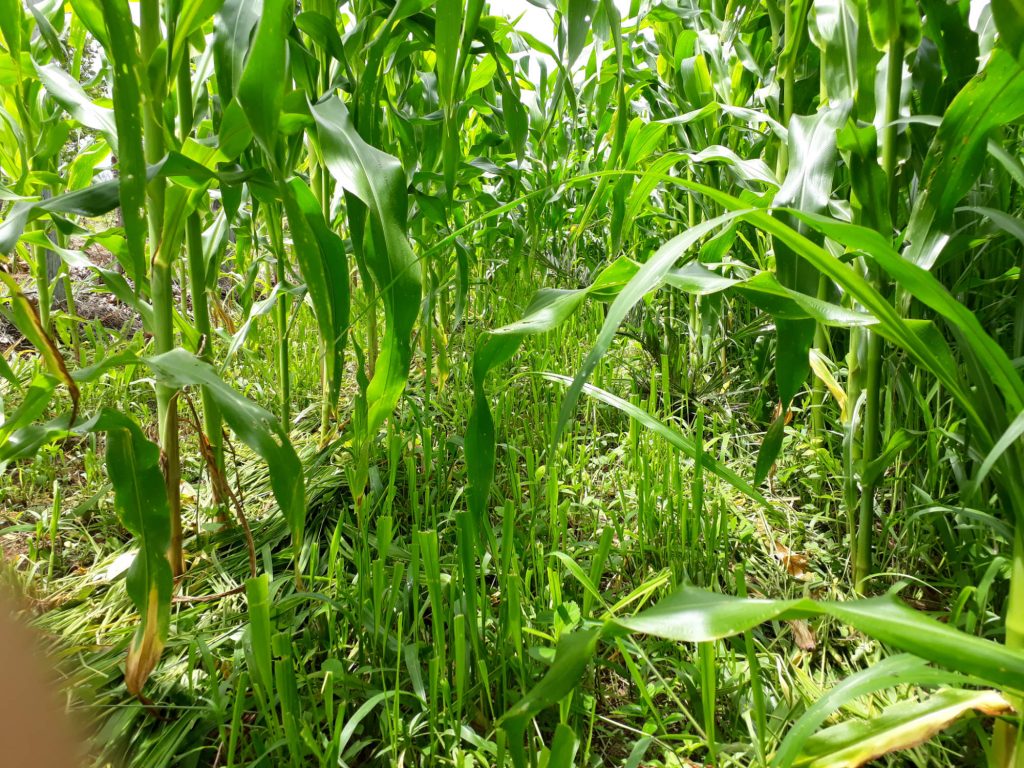
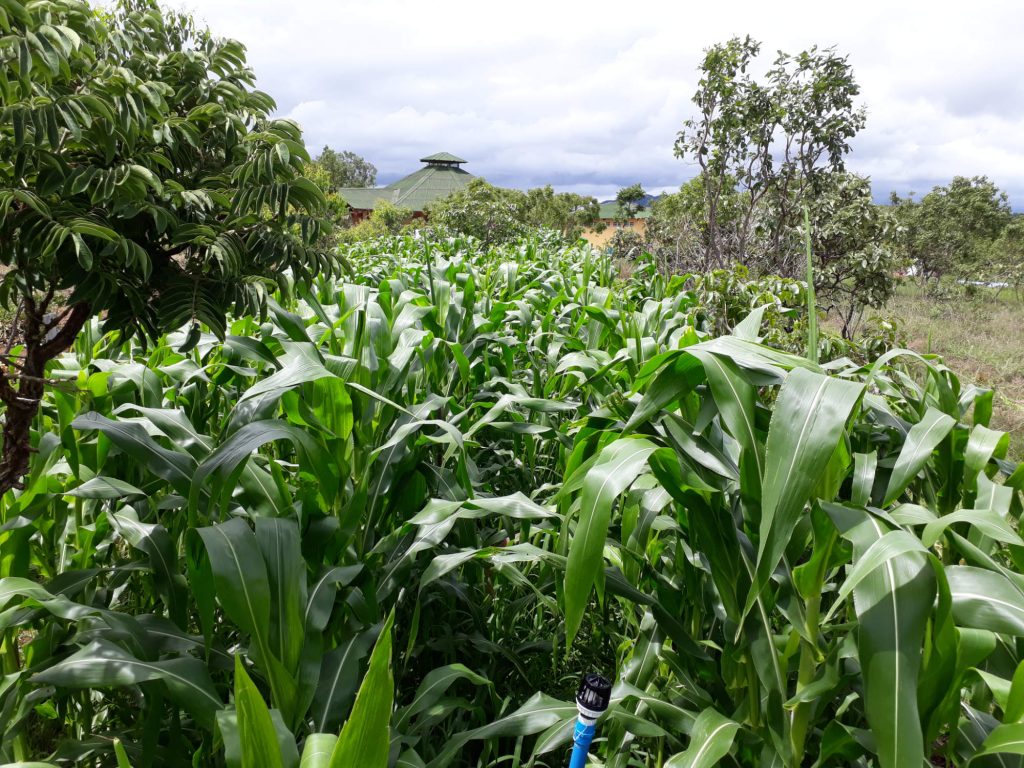

EXPERIMENT IV
Soybean with tanzania grass (Panicum maximum)
Soybean (Glycine max L.), also known as soya bean or Chinese beans, is a plant in the Fabaceae family, which also includes plants such as beans, lentils and peas. It is used for human consumption (in the form of soybean oil, tofu, soy sauce, soy milk, miso, soy protein etc.) and animal consumption (for the preparation of animal food). The plant originates in China and Japan.
In this experiment, a variety of non-transgenic soybean called sambaíba was used, which was provided by Brazilian Federal Agency for Agricultural and Livestock Research (EMBRAPA) in the State of Maranhão (Brazil). Soybean was sown with a 1m x 10cm spacing. The space between lines was sown with four lines of tanzania grass. During the soybean cycle, grass was mowed five times (see Figure 2). The area was chalked and, at the time of planting, we used chicken manure and thermophosphate. During the soybean cycle, two coverages were made: the first with chicken manure and the second with castor bean cake – because the soybean was not inoculated and turned yellow. After 70 days, two inoculant sprays (Rhizobium) were applied in order to stimulate root nodulation, in an attempt to compensate the non inoculation of the seeds at the time of planting. After 30 days, several roots were unearthed to evaluate the nodulation considered positive, as shown in Photo 23. There was no spraying of herbicides or other agrochemicals, either to combat bugs, beetles or fungi, since they did not reach the damage level.
In our region, monocultivated soybean might have a plant population ranging from 150,000 to 300,000 plants per hectare. The smaller this number, the more the plant invests in the secondary branches that can also flower. When the number of individuals per hectare is higher, fruiting happens only on the main stem. A survey was carried out on eight farms in the Chapada dos Veadeiros region, with monocultures of transgenic soybean. The number of plants per hectare, the number of pods per plant and the productivity in kg/ha were evaluated (see Table 5). The results were compared with soybean sown with tanzania grass, massai and tree lines.
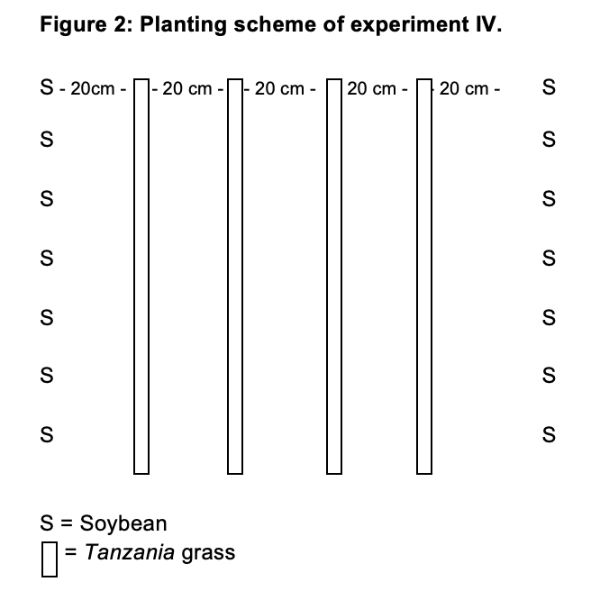

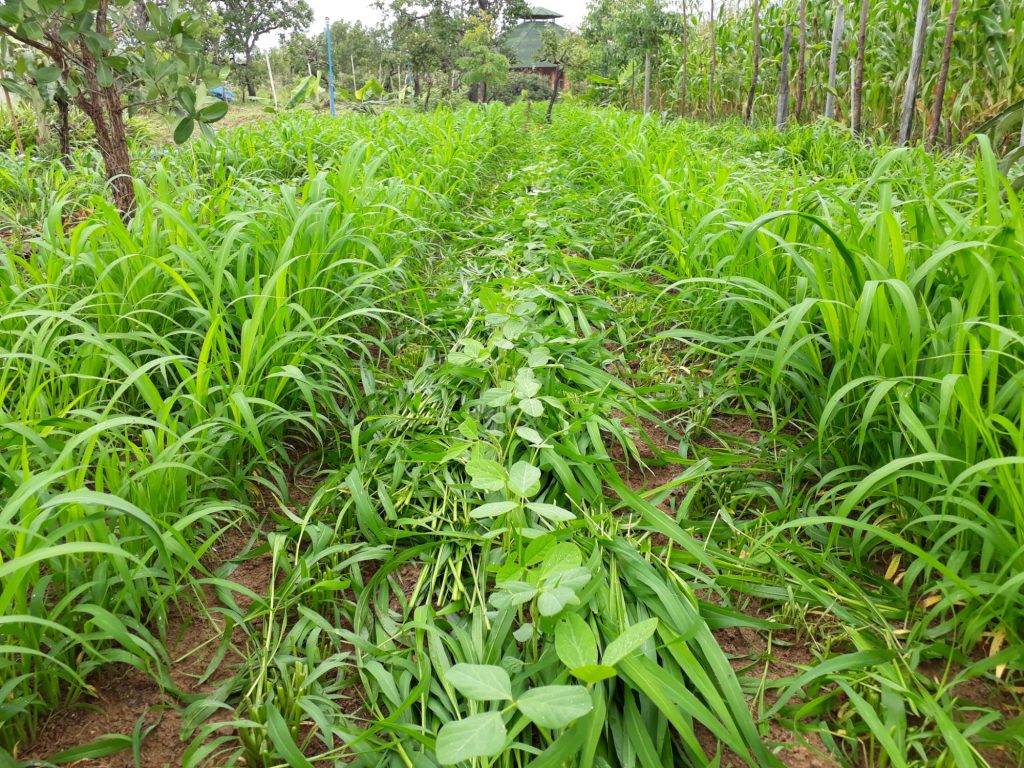

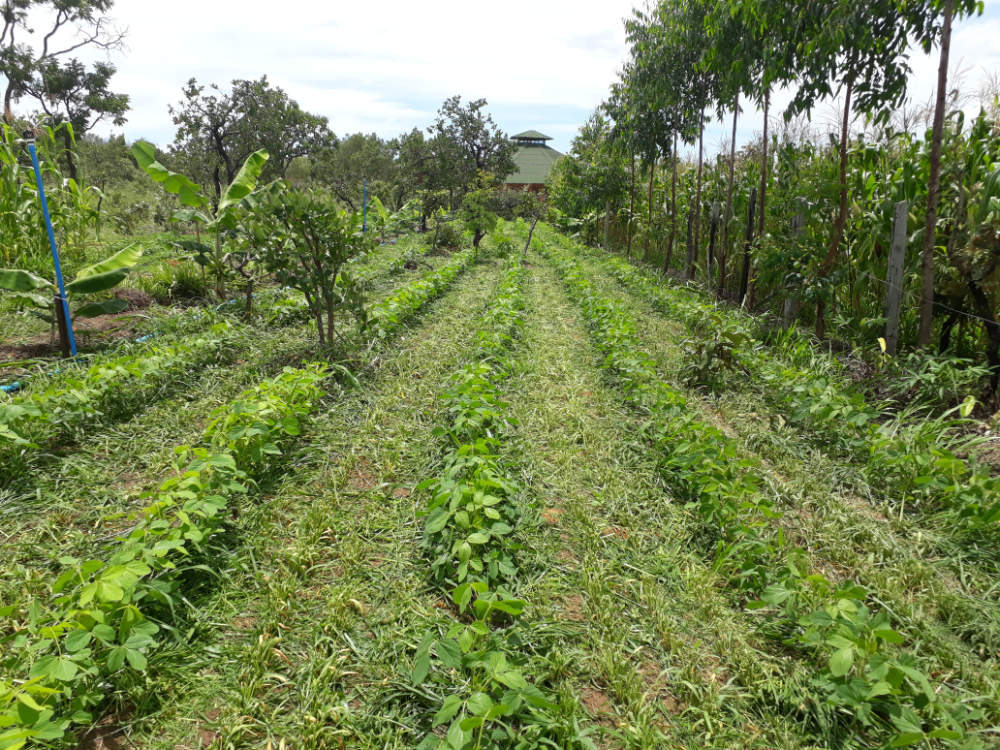


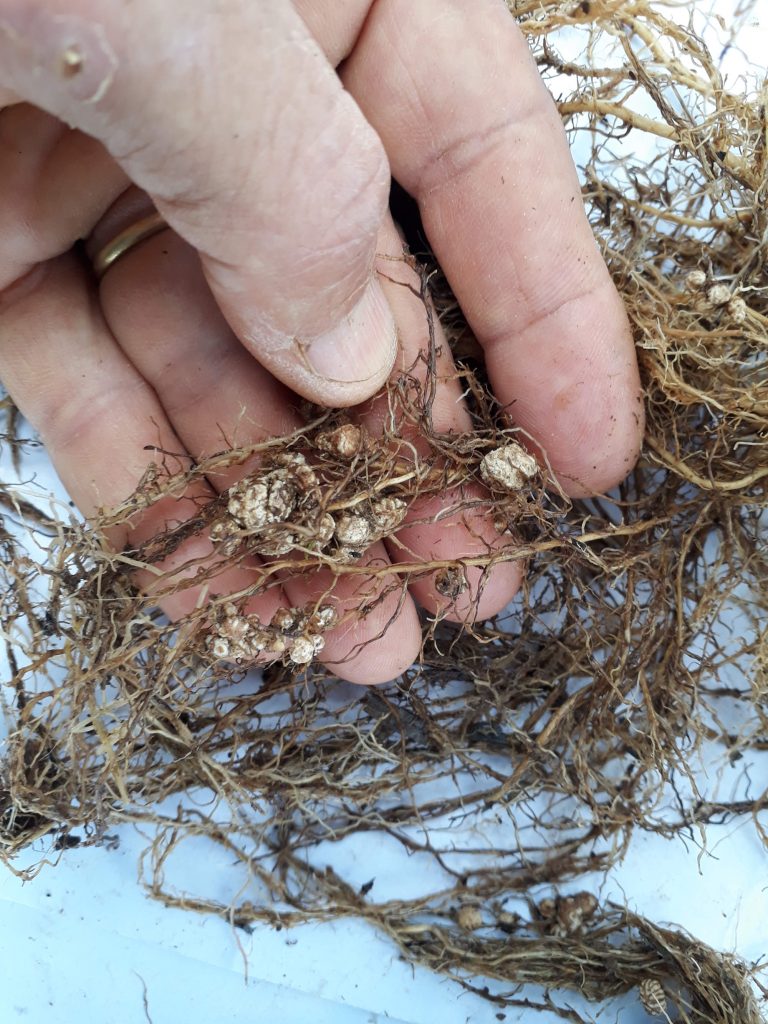
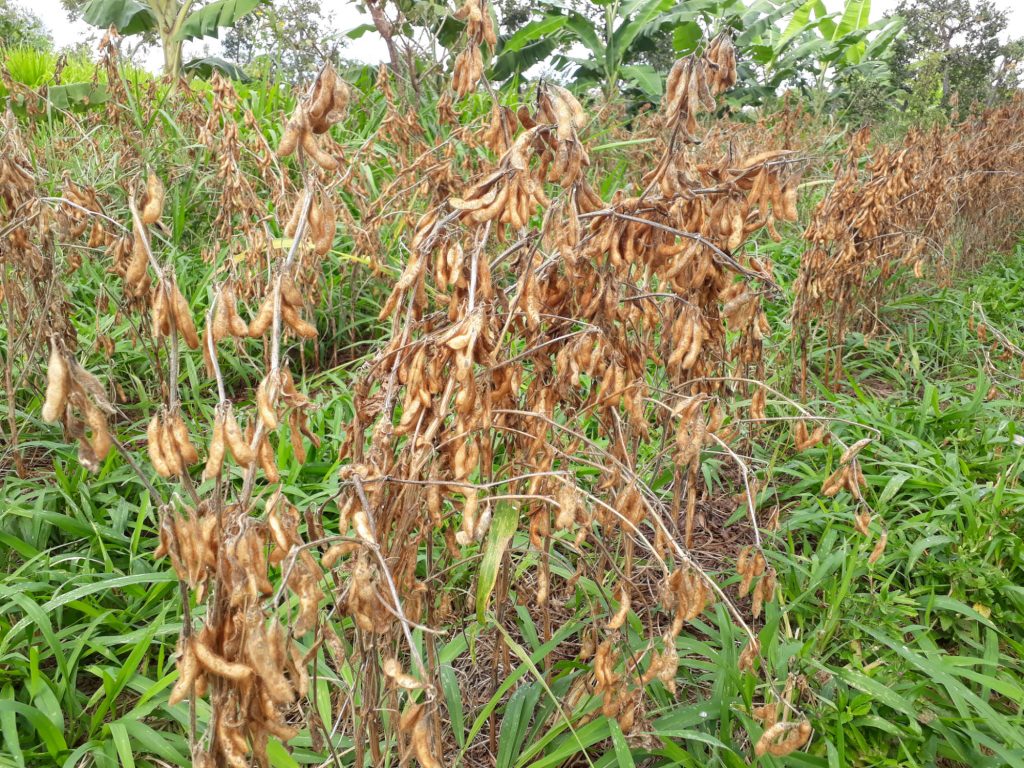

EXPERIMENT V
Soybean with massai grass (Panicum maximum)
Two non-transgenic soybean varieties were sowed: sambaíba and tracajá, provided by Brazilian Federal Agency for Agricultural and Livestock Research (EMBRAPA) of the State of Maranhão (Brazil). Soybean was sown in the spacing of 60cm x 10cm. The space between lines were seeded with three lines of massai grass every 15cm (see the planting scheme in Figure 3). During the soybean cycle, grass was mowed three times (Table 4). The area was chalked and, at the time of planting, we used chicken manure and thermophosphate. During the soybean cycle, two coverages were made: the first one with chicken manure and the second one with castor bean cake – because the soybean was not inoculated and turned yellowed. After 40 days, two inoculant sprays (Rhizobium) were applied, in order to stimulate rood nodulation, in an attempt to compensate the non inoculation of the seeds at the moment of planting. No spraying of herbicides or other agrochemicals was carried out, either to combat bugs, beetles or fungi etc., as they did not reach the damage level.
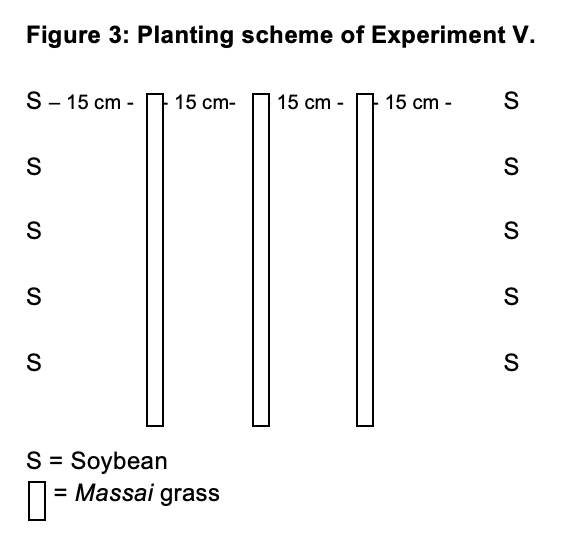

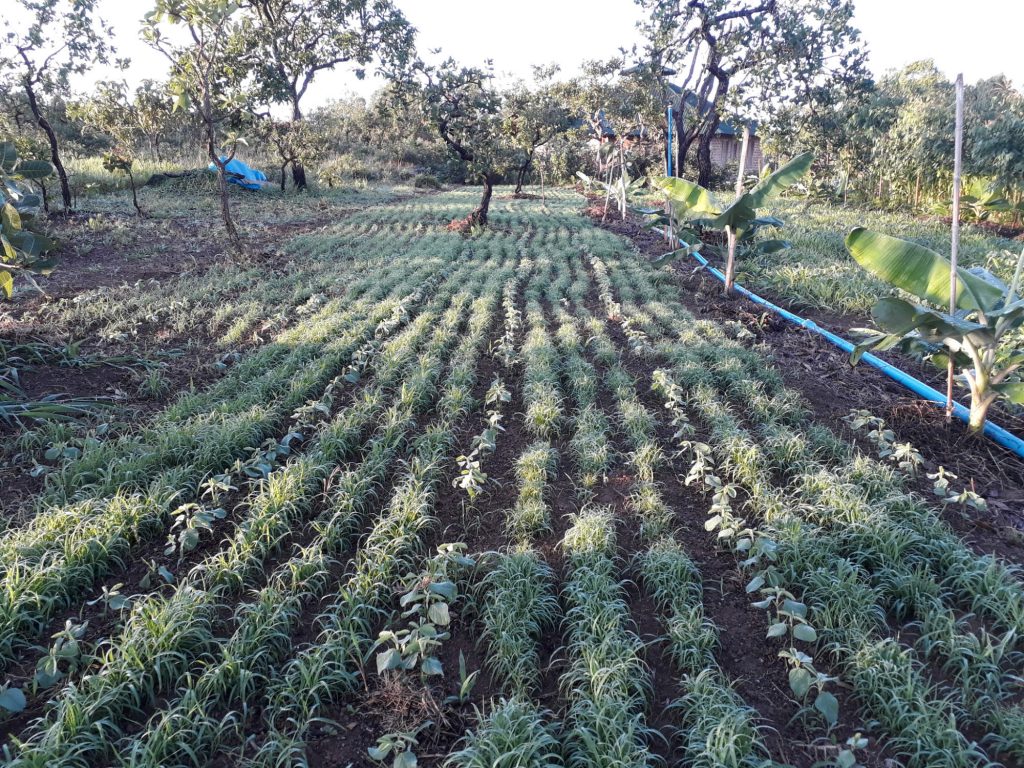
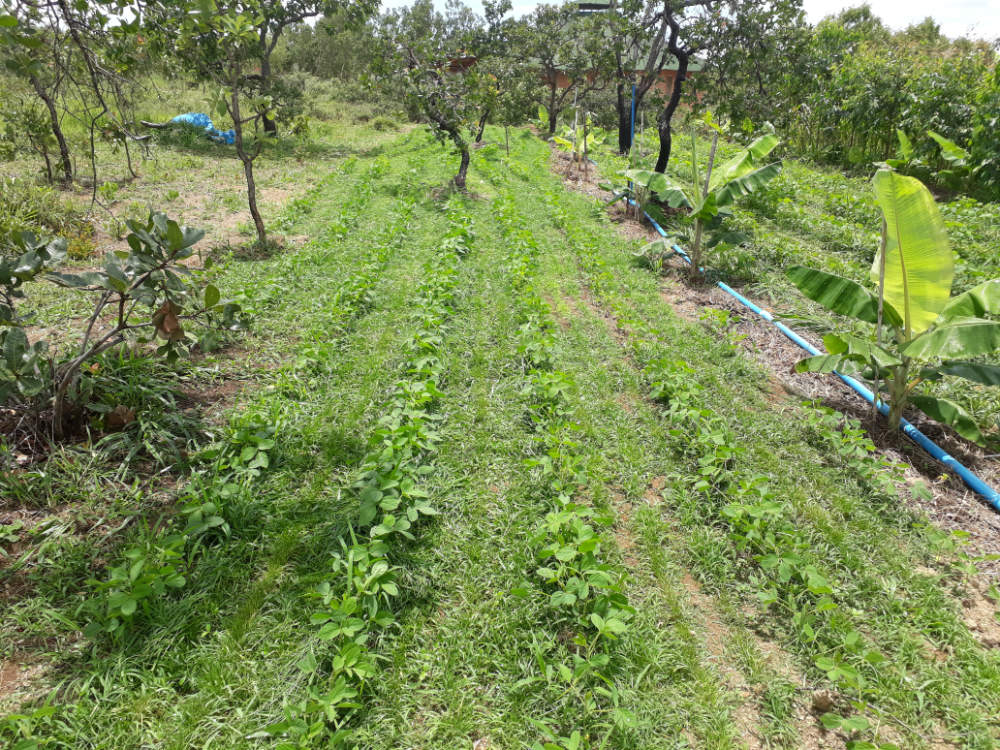



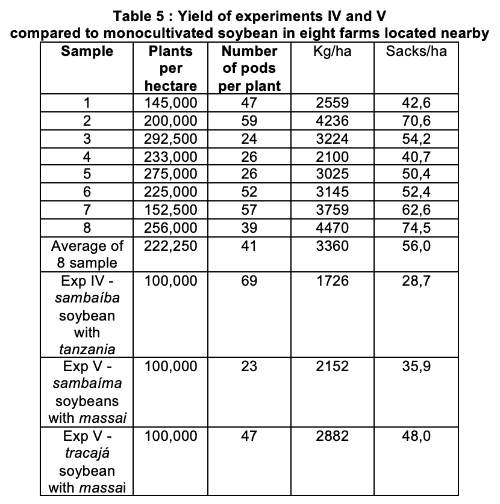
CONCLUSION:
The wheat crop presented a productivity of 1965 kg/ha, close to the national productivity average when planted to monoculture (2800 kg/ha). Table 6 shows the results of the soil analysis performed in the experimental area. This analysis shows low levels of almost all macro and micronutrients, indicating only 2ppm of available phosphorus, which is one of the fundamental elements for plant growth, both in the aerial part and in the roots. It was applied 30g/m of thermophosphate (18% P2O5) in the experimental area. The experiments were carried out in fallow land for six years, with strong soil compaction and low amount of organic matter. Due to the absence of adequate machinery and financial resources, no subsoiling was used in any experiment, which would be recommended.
As hypotheses for explaining the productivity below the national average, we can mention: the delay in planting (done at the end of the planting break), soil compaction and poor fertilization. Once these items are corrected in the next experiments with wheat, we believe that productivity may be higher. When planted to monoculture, the wheat crop can reach eight tons per hectare, as shown in the article by Juliana Caldas, published in 2017 on the EMBRAPA website. However, it is always necessary to evaluate very well the news on superproductivity in monocultures. The same article presents the testimony of the engineer-agronomist responsible for the area, Claudio Malinski. In his words: “The cost of it [wheat planting] is a little higher because it needs more inputs, more investment, more irrigation, it uses more pesticides, leaf fertilizers and micronutrients”. Sustainable agriculture is moving in the opposite direction: it does not use agrochemicals, it uses fewer and fewer fertilizers, less and less irrigation, less and less inputs, having low costs and small investments. This is the only way to guarantee the future of humanity.
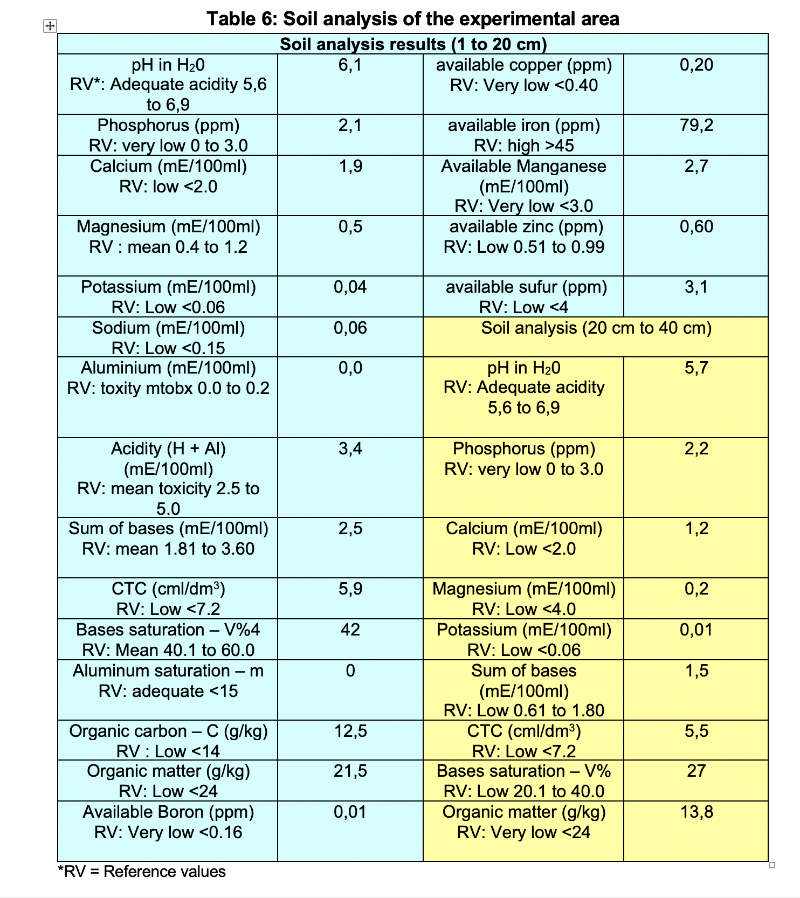
In the experiments with maize and grass, we still haven’t detected the ideal number of plants per hectare. Because we had issues with the maize lines, this may have masked grass behavior. For example, there is an ongoing experiment with maize, with exactly 50,000 plants per hectare, where different grasses were tested between the lines. It was observed that the strong and homogeneous shade of this maize density strongly influenced grass growth – all panicuns (massai, tamani, mombaça and tanzania). In their place of origin, the African Savannah, the panicuns behave as low strata, that is, they tolerate the shade of trees and shrubs. However, in the genetic improvement of these grasses, genotypes traditionally tolerant to the sun were selected. We need to search for genotypes of these shade-tolerant grasses, and at the same time we must increase both the maize density in the line and the spacing between lines. As an example, Ernst Götsch mentions the planting of rubber trees at 7 m x 7 m (Ernst Götsch’s personal communication). This way, the cocoa planted below the trees did not develop well. However, when planting rubber trees in narrow double rows and having a longer spacing (for example, 14m between the double lines of rubber trees) it is possible to plant cocoa and other trees between the lines, with practically the same density of rubber trees per hectare in homogeneous spaces. The researcher Ernst Götsch has already tested this for eucalyptus in silvopastoral systems and palm kernel, allowing the cultivation of other plants of different strata – one of the principles of syntropic agriculture. With this, we open a wide range of possibilities, aiming to concentrate cultivated plants in the line and to increase the spacing between lines, which can be occupied by grasses, legumes and other perennial plants that are both resistant to pruning and large biomass producers.
Experiments with soybean – testing two different spacings (0.6 m and 1 m), two soybean varieties and two types of grasses – allowed us to conclude that:
1) Tanzania and mombaça grasses, as they are much taller than the massai and tamani ones, require more successive cuts, until soybean is strong enough and overlaps these grasses, because at the beginning soybean grows quite slowly. Tanzanian grass required five cuts. However, as we had to wait for the rain to stop so we could harvest the soybean, another tanzanian grass mowing was necessary to facilitate harvesting – unlike the area with massai grass, where the grass was mowed only three times.
2) Massai and tamani grasses require less cuts during the soybean cycle; on the other hand, during this period, they produce less and less lignified biomass.
3) In the case of soybean planted with a 60cm spacing and three rows of massai in the space between lines, it was noticed that soybean closed the line very early, shading them for a long period and causing the death of massai grass, which may be negative if we seek a perennial soil cover throughout the year, a fundamental factor to keep alive the soil microlife and protect the soil from wind, rainfall, solar incidence, etc, in addition to having constant photosynthesis throughout the field.
4) The ideal is to sow the grass homogeneously between the lines, therefore we cover the soil evenly and avoid the appearance of early flowering herbs, which can transmit senescence information, interfering negatively in the full development of the economic culture. In the experiments, we chose to sow the grass in lines to make the planting easier to be done by people with not much experience in agriculture, since we often work with volunteers.
5) The productivity that was below the average in both soybean varieties may have other causes, besides low soil fertility, late planting (Cruz et al, 2010) and the use of varieties not adapted to the region’s climate, since it was used the materials selected for planting in Maranhão, chosen because we were looking for high no transgenic soybean varieties (conventional varieties). Contacting EMBRAPA, these varieties were indicated and, according to the researcher Marcio Armando, even though they are short when planted in Maranhão, they could exceed 1m height if planted in the Center West (in fact, the plants reached up to 1.1 m height). The idea is that with tall varieties the number of times of grass mowing between the lines decreases. Consulting the literature to understand why there are so many empty pods in the sambaíba variety, or with less than three seeds per pod, we find this observation in the book, SOY – Factors Affecting Grain Growth and Yield [SOJA – Fatores que afetam o crescimento e o rendimento de grãos ] (Mundstock et alli):
“The opposite situation occurs with cultivars that delay flowering excessively and there is an exaggerated vegetative growth. It forms a great number of branches and, consequently, of nodes as well. These may originate flowers, but the rate of floral and vegetable abortion will be very high, causing imbalance between vegetative and reproductive growth. This happens to cultivars not adapted to the photoperiod conditions and the local temperature”
6) Soybean planted with a 1m spacing and 4 rows of mombasa grass in the space between lines kept the grass alive throughout the cycle, but it is still early to assess whether this will occur in the farmers’ areas, as we had issues with soybean plants in the lines and we had lines in which soybean grew without problems and also closed the corridors completely (later, comparing to soybean and massai), which also caused the death of tanzania grass. Thus, it is necessary to repeat the experiments by testing the same spacing principle proposed above by Ernst Götsch, as in the case of rubber trees with cacao, eucalyptus and palm kernel. That is, increasing the number of plants per meter in the line with the tested spacings and also increasing the spacing between the lines and the number of plants in each line, thus we can guarantee the perennial coverage of the fields.
It is also worth remembering that we will always have the perennial tree lines every 4 m, 5 m or 6 m throughout the field, guaranteeing live roots all year long to feed the soil microlife. If we are not successful in keeping the grass alive between the more spaced lines, or if productivity is very low, one possibility would be to bring the tree lines closer together.
The experiments were very useful to evaluate both the grains and the grasses behaviors. Very subtle data have been obtained, such as deficient grass growth when they do not receive the light of the rising sun. In discussions with Ernst Götsch, he increasingly deepens the understanding of how to consorciate plants. His guidance is fundamental to the testing progress. At present, maize cultivation has more than 90,000 plants per hectare, but this density makes it almost impossible to grow in the space between lines lower perennial plants that tolerate such shading. Therefore, it is necessary to test various plant densities. When we increase line spacing, it may be more beneficial to the soil, because it maintains a healthier grass with a higher photosynthetic rate, which can also be beneficial to cultivated grains (a rhizosphere with sugar surplus and oxygen may be more beneficial for the soil biocenosis). Finally, we should never maximize soybean production to the detriment of parameters that indicate a better health of our soil and its biocenosis, since these are fundamental parameters that guarantee a long-term soybean crop, an agriculture of 40 centuries.
If we do so, we could at first suppose that there would be a reduction in the absolute production of grains per hectare. However, despite the results obtained, it is still early for such a statement, as we are working on very impoverished soils. When we start from a broad view and see our fields as an extension of the Earth, an extension of the native forests, each visit to the fields is intended to leave the place better than we found it. This way, the harvest is only a by-product. This naturally generates a much more sustainable production and, in the end, that is what counts. The difference between cost and revenue is fundamental, but this difference, what we usually call profit, has value only if there is no dilapidation of the natural patrimony (soil, water, air, climate, wild animals, etc). Therefore, it is fundamental to make sure that we are walking in the direction of making life prosper. Thus, we have to look not only at profits but also at ecological factors, such as soil preservation, non-use of poisons of any kind, water conservation, local climate regulation by trees and, last but not least, the feeling of giving back to Nature all that it has offered us here, after countless generations.
NEXT STEPS:
The experiments presented in this article were the first tests aiming to combine grasses and grains, which is something really innovative and revolutionary, as the results indicated that it is feasible and viable. For further research, we indicate below the next steps to be followed, in order to eliminate unnecessary variables and to clarify more and more this possibility.
1) Repetition of the experiments in soil commonly used for grain production, with adequate levels of nutrients and organic matter, allowing to eliminate the ‘low soil fertility’ variable. With this, the consortia can be evaluated in real field situations, where they are expected to achieve similar or even higher productivity to the national average. Some rural producers of the Group of Sustainable Agriculture (GAS) have already been willing to repeat the experiments on their lands.
2) Soil analysis of the 8 soybean samples, in order to evaluate the ‘fertility’ variable, comparing each farm’s productivity to the soil fertility. Repetition of soil analysis in the experimental areas, mainly where soybean was cultivated, trying to evaluate if and how much soil fertility improved after this first cultivation, and if and how much this fertility impacted the productivity.
3) Performing experiments with maize by testing longer spacings with higher plant densities in the lines (Table 7), as shown in another experiment not yet published, in a maize stand of 50,000 plants per hectare (1 m x 0.2 cm of maize spacing with grass lines), maize grew quite vigorously, and when the area was heavily shaded, part of the grass between the lines died after mowing, which cannot happen, since after the harvest the soil is completely uncovered and we stop maximizing photosynthesis.

In experiments with maize lines every 2 meters, we will also test the planting of bean lines (looking for a high variety) between the grass lines.
4) Conducting experiments with soybean, testing both the same spacing and larger spacing between the lines, with greater soybean grain densities in the line, thus allowing grass to receive more sunlight during the soybean cycle.
5) Performing experiments with soybean, maize, sorghum and cotton, with grass between lines and tree lines every 6m, with the following variables: organic fertilizer, rock dust and fermented microorganisms, according to Table 8.

6) Creating homogeneous fields that portray large-scale planting faithfully. In the experiments we had eucalyptus and banana lines along with young native trees. Therefore, we can get results much closer to what is really going to happen in thousands of hectares, with line trees every 6m.
Theres is much to be developed and tested in large-scale syntropic agriculture, which seeks to recreate the environment where plants have coevolved for thousands of years. Carrying out this type of agriculture in a mechanized way in thousands of hectares will not only transform the rural landscape of the planet, but also guarantee the future for the human species, because, if there will be a future for us, it is intrinsically connected to the restoration of the entire Earth.
The Research Center for Syntropic Agriculture – CEPEAS, is a non-profit institution. If you are interested in contributing to our research, please contact us: vidaemsintropia@gmail.com (Fernando Rebello).
BIBLIOGRAPHY:
CALDAS, Juliana. Fazendo no Cerrado registra recordo brasileiro na produtividade de trigo. EMPRAPA, 2017. Availble at: <https://www.embrapa.br/busca-de-noticias/-/noticia/29565199/fazenda-no-cerrado-registra-recorde-brasileiro-na-produtividade-de-trigo>. Acess: 06/05/2019.
CRUZ,Thyane Viana da et alli. Componentes de produção de soja em diferentes épocas de
Semeadura, no oeste da Bahia. Biosci. J., Uberlândia, v. 26, n. 5, p. 709-716, Sept./Oct. 2010.
GÖTSCH, Ernst. Comunicação pessoal. Workshop “Agricultura Sintrópica”. Alto Paraíso de Goiás, Brazil, 2019.
MUNDSTOCK, Claudio M. et alli. Soja: Fatores que afetam o crescimento e o rendimento de grãos. Porto Alegre: Universidade Federal do Rio Grande do Sul, 2005.




